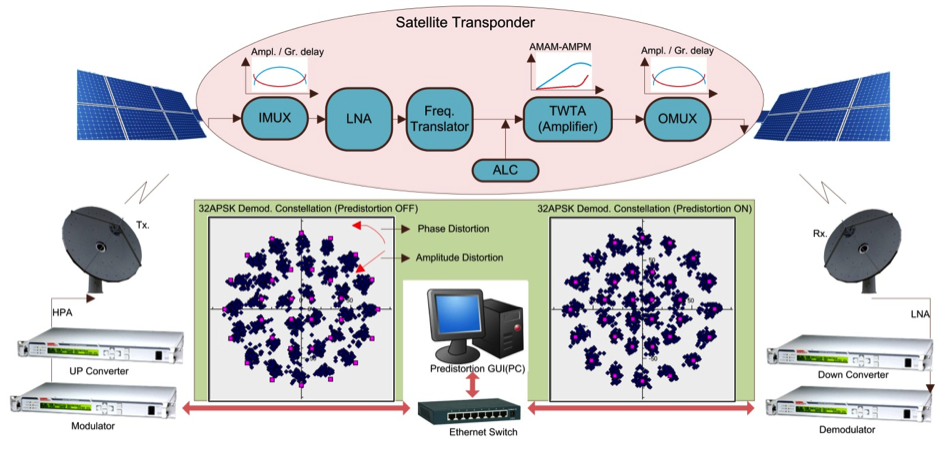
Chakradhar Penuballi
Predistortion algorithms are introduced in DVB satellite modulators and modems to compensate for the negative effects of filters and amplifiers at the satellite. Using linear and non-linear predistortion methods, operators can reduce self-interference of the signal passing through the satellite transponder. These methods improve the signal-to-noise ratio of the end-to-end satellite communication link by a reasonable gain and subsequently enhance the satellite link to operate with less back off and higher power. Ultimately, this performance gain will increase beam coverage or ensure higher throughput in the same satellite capacity.

Figure 1. Operational setup demonstrating the benefits of non-linear static predistortion
A basic predistortion working setup is shown in Figure 1. In particular, the linear predistortion algorithm is designed to compensate group delay distortion caused by the IMUX and OMUX filters of the satellite transponder. The non-linear static predistortion algorithm compensates for the non-linear AM/AM, AM/PM behavior of the satellite amplifier (TWTA), which creates degradation by moving the symbols in the I/Q plane away from their ideal positions, especially for higher modulation types 16APSK and 32 APSK. Operators can also enable a non-linear dynamic predistortion algorithm to compensate for higher inter-symbol interference also caused by AM/AM, AM/PM nonlinearities.
All predistortion algorithms are implemented based on a PC program, offering easy access through a user-friendly GUI that communicates with the modulator, demodulator or modem via an IP interface. Demodulator constellation points are visualized in the GUI to analyze the achievement of predistortion at the receiver. For example, 32 APSK constellation points are shown in Figure 1 for cases with and without transmit side static non-linear predistortion.
Using the DVB-S2 mode transmission with predistortion techniques, operators can optimize the transmission performance, bringing it very close to Gaussian ideal performance. A DVB-S2 8PSK modulation type with predistortion combined with a good receiver equalizer can achieve an Es/N0 gain of 0.6 dB to 1.0 dB. Similarly, a DVB-S2 16APSK/32APSK modulation type with predistortion and a good receiver equalizer can achieve an Es/N0 gain of 1.0 dB to 2.4 dB. The Es/N0 gain is calculated at the system threshold operating point when the satellite is functioning at an optimal OBO.
The advantage of WORK Microwave’s predistortion technology is that it runs automatically in the background without interrupting the live transmission.

